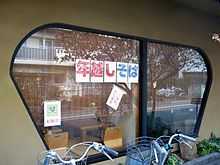Toshikoshi soba

Toshikoshi-soba(年越し蕎麦), soba-shop(蕎麦店), Tokyo, Japan.
Toshikoshi soba (年越し蕎麦), year-crossing noodle, is Japanese traditional noodle bowl dish eaten on New Year's Eve. This custom lets go of hardship of the year because soba noodles are easily cut while eating.[1]
History
The custom differs from area to area and it is also called misoka soba, tsugomori soba, kure soba, jyumyo soba, fuku soba, and unki soba. The tradition started around Edo period (1603-1867) and there are several theories believed that long soba noodles symbolize a long life.[2] The buckwheat plant can survive severe weather during growing period, soba represents strength and resiliency. Also, goldsmiths used to gather gold dust by soba flower, hence soba is believed to bring good fortune.[3]
See also
References
- ↑ Bill Daley, "New Year's Eve noodles: A savory end to the old year", Chicago Tribune
- ↑ Bill Daley, "A savory end to the old year: Soba caps busy New Year's Eve", December 29, 2010, Chicago Tribune
- ↑ Makiko Itoh, "Why not spend New Year’s Eve totally soba?: Slurping up the history behind Japan's tasty tradition of yearend noodles", December 24, 2010, The Japan Times